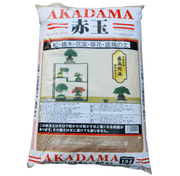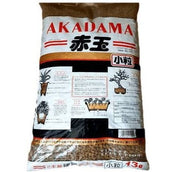Akadama Double Line (HARD) Japanese Bonsai Soil 14L
Akadama is a naturally occurring, hard-baked volcanic clay soil from Japan. It is widely used in horticulture, particularly in bonsai cultivation, due to its excellent drainage, aeration, and moisture retention properties. Akadama granules break down over time, improving the soil structure and aiding root development.
Available grain sizes:
- 1-2 mm
- 3-6 mm
Produced from the second hard red jade soil of Ibaraki, Japan. Its fresh, auburn, round particles absorb water easily. The hardness is higher than that of the spring, which is more suitable for paving. This is a rare substance composed of volcanic ash. This is also a soil medium widely used in countries such as Japan. It can be described as a high-permeability volcanic mud with a round shape, free from harmful bacteria, and a slightly acidic pH. Its shape is conducive to water storage and drainage. The percentage generally mixed with other substances is 30-35%, which is higher than that of peat. The effect is comparable to peat. Suitable for all kinds of potted plants.
Analytical data of red jade soil content:
SiO2 (silica): 42.7%
CaO (calcium oxide): 0.98
MgO (magnesium oxide): 2.5%
MnO (manganese oxide): 0.15%
Fe2O3 (iron oxide): 8.4%
Al2O3 (alumina): 25.1%
PH value: 6.9
EC value: 0.052ms/cm
Kanuma and Akadama are both popular soil amendments used in bonsai cultivation, but they have distinct properties and are suited for different types of plants. Here's a detailed comparison and information on how to use Kanuma for bonsai and other plants:
Kanuma
Composition:
-
Kanuma is a type of volcanic soil that is highly acidic, with a pH typically ranging from 4.5 to 5.5.
-
It is lightweight and has excellent water retention and drainage properties.
Suitable Plants:
-
Kanuma is particularly well-suited for acid-loving plants such as azaleas, camellias, and rhododendrons.
-
It is also used for other bonsai species that prefer slightly acidic soil conditions.
Usage:
-
Preparation: Before using Kanuma, it is often recommended to sift it to remove fine particles and dust. This helps improve aeration and drainage.
-
Mixing: Kanuma can be used alone or combined with other soil components, such as Akadama, pumice, or lava rock, to create a custom soil mix. A typical mix for azaleas might be 70% Kanuma and 30% Akadama.
-
Potting: When potting or repotting, ensure that the Kanuma is evenly distributed around the roots. Gently tap the pot to settle the soil without compacting it too much.
-
Watering: Kanuma retains water well, so be mindful not to overwater. Allow the top layer of soil to dry out slightly between waterings.
Akadama
Composition:
-
Akadama is a hard-baked Japanese clay that is neutral to slightly acidic, with a pH typically ranging from 6.0 to 6.5.
-
It is heavier than Kanuma and has good water retention and drainage properties, but it tends to break down over time.
Suitable Plants:
-
Akadama is versatile and can be used for a wide range of bonsai species, including pines, maples, and junipers.
-
It is particularly favoured for its ability to provide a stable environment for root growth.
Usage:
-
Preparation: Like Kanuma, Akadama should be sifted before use to remove fine particles.
-
Mixing: Akadama is often combined with other components, such as pumice and lava rock, to create a well-draining soil mix. A typical mix might be 50% Akadama, 25% pumice, and 25% lava rock.
-
Potting: When potting or repotting, ensure that the Akadama is evenly distributed around the roots. Gently tap the pot to settle the soil.
-
Watering: Akadama retains water well but also drains efficiently, so it requires regular watering to maintain its optimal condition. Monitor the soil moisture closely.
Key Differences
-
pH Level:
-
Kanuma is highly acidic, making it ideal for acid-loving plants.
-
Akadama is neutral to slightly acidic, making it suitable for a broader range of plants.
-
Weight:
-
Kanuma is lighter than Akadama.
-
Akadama is heavier, which can provide more stability for larger bonsai trees.
-
Durability:
-
Kanuma tends to retain its structure for a more extended period.
-
Akadama breaks down over time, which can be beneficial for root growth but may require more frequent repotting.
-
Water Retention:
-
Both retain water well, but Kanuma's higher acidity can influence nutrient availability.
Conclusion
Choosing between Kanuma and Akadama depends on the specific needs of your bonsai or other plants. Kanuma is the go-to for acid-loving species, while Akadama offers versatility for a broader range of plants. Both can be used alone or in combination with other soil components to create the ideal growing medium for your bonsai.
Information on using Akadama for Bonsai and other plants, and the differences with Kanuma and Kiryuzuna
Akadama, Kanuma, and Kiryuzuna are all popular soil components used in bonsai cultivation, each with unique properties that make them suitable for different types of plants and growing conditions. Below is a detailed guide on how to use Akadama for bonsai and other plants, along with a comparison of its differences with Kanuma and Kiryuzuna.
Akadama
Composition and Properties:
-
Akadama is a hard-baked Japanese clay soil.
-
It is neutral to slightly acidic, with a pH range of 6.0 to 6.5.
-
It has excellent water retention and drainage properties.
-
Over time, Akadama breaks down into smaller particles, which can aid in root development but may necessitate repotting every 1-2 years.
Suitable Plants:
-
Akadama is versatile and can be used for a wide range of bonsai species, including:
-
Conifers (e.g., pines, junipers)
-
Deciduous trees (e.g., maples, elms)
-
Tropical and subtropical species (e.g., ficus, serissa)
-
It is particularly favoured for its ability to provide a stable environment for root growth.
How to Use Akadama:
-
Preparation:
-
Sift Akadama to remove fine dust and particles. This improves aeration and drainage.
-
Soak Akadama in water for a few hours before use to ensure it absorbs moisture evenly.
-
Mixing:
-
50% Akadama
-
25% Pumice
-
25% Lava rock
-
-
Akadama is often combined with other soil components, such as pumice and lava rock, to create a well-draining bonsai soil mix.
-
A typical mix ratio is:
-
Adjust the ratio according to the specific needs of your bonsai species (e.g., using more Akadama for water-loving plants).
-
Potting:
-
Place a layer of coarse soil (e.g., lava rock) at the bottom of the pot for drainage.
-
Spread Akadama evenly around the roots, ensuring good contact between the soil and roots.
-
Gently tap the pot to settle the soil without compacting it too much.
-
Watering:
-
Akadama retains water well but also drains efficiently, so it requires regular watering.
-
Monitor the soil moisture closely, especially during hot or dry periods.
-
Repotting:
-
Akadama breaks down over time, so repotting is typically required every 1-2 years to maintain proper soil structure and drainage.
Differences Between Akadama, Kanuma, and Kiryuzuna
|
Property |
Akadama |
Kanuma |
Kiryuzuna |
|
Composition |
Hard-baked clay |
Volcanic soil |
Volcanic soil (similar to pumice) |
|
pH Level |
Neutral to slightly acidic (6.0-6.5) |
Highly acidic (4.5-5.5) |
Neutral to slightly acidic (6.0-7.0) |
|
Weight |
Heavier than Kanuma |
Lightweight |
Lightweight |
|
Water Retention |
High |
Very high |
Moderate |
|
Drainage |
Excellent |
Excellent |
Excellent |
|
Durability |
Breaks down over time (1-2 years) |
Retains structure longer |
Very durable, does not break down |
|
Best For |
Broad range of bonsai species |
Acid-loving plants (e.g., azaleas) |
Plants requiring excellent drainage |
Kanuma
-
Use Case: Ideal for acid-loving plants, such as azaleas, camellias, and rhododendrons.
-
Properties: Lightweight, highly acidic, and retains water well.
-
Mixing: Often used alone or mixed with Akadama for acid-loving species.
Kiryuzuna
-
Use Case: Suitable for plants that require excellent drainage and aeration, such as pines and junipers.
-
Properties: Lightweight, durable, and neutral to slightly acidic. It does not break down over time.
-
Mixing: Often used in combination with Akadama and pumice for conifers and other species that prefer well-draining soil.
When to Use Each Soil Component
-
Akadama:
-
Use for a broad range of bonsai species, especially those that benefit from stable root environments.
-
Ideal for beginners due to its versatility.
-
Kanuma:
-
Use for acid-loving plants, such as azaleas and camellias.
-
Avoid using it on plants that prefer neutral or alkaline soil.
-
Kiryuzuna:
-
Use for plants that require excellent drainage and aeration, such as conifers.
-
Great for long-term use since it does not break down.
Soil Mix Examples
-
General Bonsai Mix:
-
50% Akadama
-
25% Pumice
-
25% Lava rock
-
Acid-Loving Plants Mix:
-
70% Kanuma
-
30% Akadama
-
Conifer Mix:
-
40% Kiryuzuna
-
30% Akadama
-
30% Pumice
Conclusion
-
Akadama is the most versatile and widely used component of bonsai soil, suitable for a broad range of species.
-
Kanuma is specialised for acid-loving plants and should not be used for species that prefer neutral or alkaline soil.
-
Kiryuzuna is ideal for plants that require excellent drainage and aeration, particularly conifers.
By understanding the properties and differences between these soil components, you can create the perfect soil mix for your bonsai or other plants, ensuring healthy growth and development.


